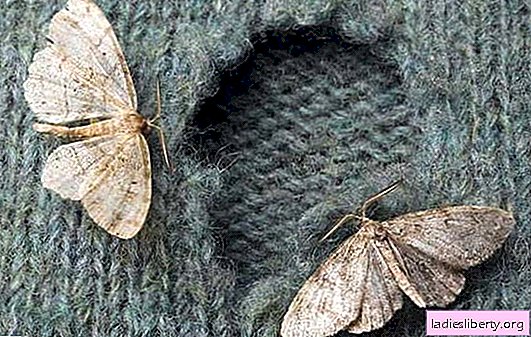
Domestic moth, despite its small size, can become a source of major trouble, especially if she settled in the dressing room or pantry.
And if this gluttonous insect appeared in the house, then getting rid of it will be very difficult, because chemicals can be dangerous to the health of residents, and alternative methods are not always effective.
In order to get rid of a moth, you must first understand where it comes from, where it lives and how it breeds, and only after that proceed with the fight against it.
Moth: causes
It is believed that moth appears only in those housewives who do not monitor the cleanliness of their homes.
However, this opinion is erroneous, since the main thing for the moth is not the condition of the room, but the presence in it of a nutrient medium for breeding offspring: products and clothes that are in every house.
Also, few know that there are a total of 14 different types of moths that have their own unique characteristics.
But if you do not go into details, they can be conditionally divided into two types, each of which enters the house in its own way.
Kitchen moth
A mole flying through the kitchen or pantry indicates that somewhere on the shelves are stored products that have larvae of this insect, and offspring have already hatched. Most often, the habitat of food moths is cereals, flour, nuts, dry animal feed, dried fruits, berries and herbs, stored in a closed poorly ventilated area. The larvae of this parasite can also appear in store products, especially if the cost of such a product is suspiciously low or the packaging is not sealed. It is food products that most often become the "vehicle" for the kitchen moth.
Kitchen moth is not able to patch over long distances, so it is extremely rare to enter the house through an open door or window, but can fly from neighbors through a common ventilation channel.
Clothing moth
This pest feeds on products made from natural materials: wool, fur, cotton, feathers, and even silk and velvet. Clothing moth can cause irreparable harm to the wardrobe, "eating" fur coats, textiles, knitwear and shoes with natural fur, as well as ruin carpets and natural upholstery. These same products are most often the carrier of the parasite. You can bring moth larvae to your house not only in second-hand clothes, but also in a new thing from the store.
Another source of the appearance of moths can be furniture brought into the house, especially wardrobes, in which contaminated clothing was previously stored. Proprietary moth rarely parasitizes on domestic animals, however, there is a possibility that their hair can also become a good carrier for this insect.
How to get rid of moths: a review of purchased funds
From childhood, our grandmothers taught us that the best cure for moths is naphthalene. However, this substance does not kill moths, but only scares away butterflies, which themselves are safe. You need to fight not so much with them as with their offspring, and for this you need to choose the most effective methods.
To the question "how to get rid of moths?" modern science knows many answers, so on the shelves of shops you can find a wide variety of moth remedies, with which manufacturers promise to rid the house of the pest once and for all. In order to make the right choice, you first need to figure out which ones are the safest and most effective.
1. Insecticidal aerosols. The principle of their action is based on the spraying in the places of accumulation of a moth a large amount of insecticide, which enters the body of the insect through the respiratory tract and causes poisoning. Aerosol is a potent chemical agent, so it kills a mole almost after the first use. It must be sprayed in all the intended habitats of insects: in cabinets, on shelves, and also processed with it products from fur and wool. The disadvantage of aerosols is their high toxicity, so after using them, the room should be well ventilated. In addition, this tool is not suitable for combating kitchen moths, as they can not process food.
2. Sections and plates from moths. Unlike aerosols, special plates and sections do not poison the air, they are easy to use and safe. Sections are mounted inside cabinets and shelves with a hanger or sticker and scare away butterflies, preventing them from sitting on clothes and leaving offspring. This tool does not destroy the insect, so it is more suitable for prevention than for getting rid of moths.
3. Fumigators. This tool will help get rid of moths, as well as other insects - flies and mosquitoes. The effectiveness of the fumigator in the fight against moths is great, but it works quite slowly.
4. Traps and adhesive tapes. These devices are designed to lure and catch adult butterflies, but are completely powerless against their larvae, therefore they are used more often as an auxiliary tool in the fight against moths. At the same time, Velcro and traps do not contain chemicals, therefore they are absolutely safe for humans.
How to get rid of moths: folk remedies and methods
Chemicals are far from the only way to combat moths. Since the moth is a living organism, you can get rid of it by creating unfavorable conditions for it. These include: direct sunlight, fresh air, high or low temperatures. Therefore, the clothes in which the moth is wound can be cleaned by simply hanging it on the street on a sunny day, or by airing it in the cold. In addition, it should be remembered that the larvae of moths are rather poorly kept on clothes, and after a good shaking, they easily detach.
Another effective method of cleaning clothes from moth larvae is washing in fatal hot water or steaming them.
To get rid of the kitchen moth, you will have to not only throw away infected products, but also take preventive measures to prevent its reappearance. To do this, wipe all the shelves on which the products are stored with a rag dipped in soapy water, especially carefully treating all hard-to-reach spots. You can also sanitize surfaces with a solution of table vinegar or alcohol.
The principle of action of store sections from moths is based on repelling insects with a strong odor unpleasant for them. Many housewives know that the moth is not only afraid of "chemistry." Even ordinary geranium, which has a specific smell, has long been considered not only a beautiful indoor plant, but also a remedy against moths. Also, this insect is afraid of many other smells, among which we can distinguish:
• lavender oil or dry lavender;
• tobacco;
• orange or lemon zest;
• garlic;
• thyme;
• wormwood;
• St. John's wort;
• eucalyptus.
How to get rid of moths: the secrets of keeping wool and fur products
It is already impossible to restore the original look to your beloved things that are damaged by moths, so it’s much more important not to think up how to get rid of the moth, but not to allow it to appear. For this, it is necessary to adhere to several simple rules for storing and caring for wool and fur things:
1. Get rid of unnecessary things. There is hardly any future use of a decrepit fur coat or an old fur hat, but they can be a good platform for breeding moth offspring.
2. Before you put things in a closet, wipe all shelves and doors with soap and water and then carefully ventilate the apartment. Clothes can only be put on shelves after the cabinet is completely dry.
3. Leave for long-term storage only clean things. Dirt and stains on clothing can become an additional bait for moths. Therefore, before you hide things in a closet, wash them and thoroughly dry them in the sun.
4. Store fur products in a cool, dry place. It is better to pack a fur coat in a special cover made of thick paper. Conventional thin polyethylene is not suitable for these purposes, as the moth gnaws at it easily. You can also put a special moth plate inside the case. The fur coat in the cabinet should hang freely so that the pile does not wrinkle.
5. Woolen blankets and sweaters must be carefully folded and packaged as tightly as possible.
6. Small fur products can be wrapped in newsprint: the smell of printing ink also repels moths well. Also crumpled pieces of newsprint can be put inside shoes with fur lining.











